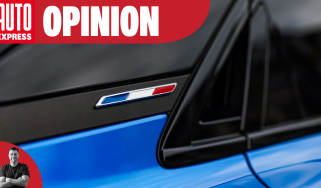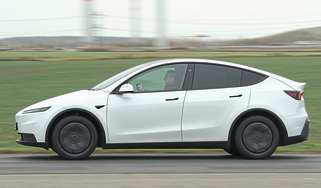Driving in Europe: what are the rules for UK motorists?
Everything you need to know about taking your car to Europe

There’s more to driving in Europe than just changing to the other side of the road. There were some changes to the rules and regulations for Brits wanting to take their cars abroad post-Brexit in 2016, but happily if you want to drive across the channel for short-term leisure or tourism purposes things are pretty much as they were before we left the EU.
That means any driver with a car legally insured for road use in the UK automatically gets third party cover to drive that car in the EU too, so if you’ve got a valid insurance policy document there’s no need to inform your insurer about your trip if you simply want to stay legal. However, it stands to reason that most drivers will want to maintain comprehensive cover abroad, in which case you’ll have to check with your policy provider.
Either way, there’s no need to ask your insurer for a green card - which offers recognised proof of insurance internationally - unless your planned trip includes any European countries outside the EU. There’s no need for an International Driving Permit in EU countries either, as the UK licence is fully recognised in all member states as entitlement to drive.
You can take a car to the EU where it can be driven for up to a year on foreign plates before being considered an import, at which point it would need to be re-registered locally. That’s unlikely to be an issue for most leisure travellers from the UK, who are only allowed to visit EU countries for 90 days out of any 180 unless they have a long-stay visa.
One complication for British drivers abroad that isn’t Brexit related is the Crit’Air permit scheme for cars entering low-emissions zones in many French cities. You can order window stickers for less than a fiver online in advance of your trip via the French government website - - but they’ll take a couple of weeks to arrive.
Documents required for UK drivers visiting the EU
|
Documents you NEED |
Documents you DON’T NEED |
|
|
What must you take with you in the car for driving in Europe?
|
Items you NEED |
Items you DON’T NEED |
|
|
‘Emergency extras’ worth considering for driving in Europe
- Replacement bulbs - not compulsory, but recommended
- Fire extinguisher - do you know how to use it?
- Water/snacks/suncream or blankets - especially for kids
- Global Health Insurance card - free via the NHS website
It’s generally no more complicated to drive overseas than here in the UK, but there are crucial differences apart from being required to drive on the ‘wrong’ side of the road. Some of the most important variables can be speed limits, rights of way at junctions or roundabouts, and alcohol restrictions.
So if you’re heading to the continent for work or pleasure, check out our detailed guide below for advice on what you’ll need to consider to make sure your journey is as seamless as possible.
Insurance
Check precisely what you’re covered for when driving in the EU with your insurance company, and do it well before you travel. If you have a UK insurance policy on your car it will automatically provide third party cover for driving in EU countries. You may well want fully comprehensive cover, though, and that’s where you’ll need to check your policy and potentially make additional arrangements with your insurer. If you are involved in an accident when driving in the EU, a comprehensive European insurance policy will be worth its weight in gold.
Make sure you take your driving licence with you when driving in the EU, as well as the logbook for the car you’re driving, plus a copy of your current insurance policy. Since 2 August 2021, drivers have no longer had to obtain an insurance green card to drive their vehicles to any EU country or Andorra, Bosnia & Herzegovina, Iceland, Lichtenstein, Norway, Serbia and Switzerland.
You may need to carry a green card if you’re driving in Albania, Azerbaijan, Belarus, Moldova, Russia, Turkey, Ukraine. Multiple green cards may be needed if you’re towing caravans or trailers. Make sure you tick the correct green card category according to your vehicle and towed vehicle.
To get a green card, contact your insurer to get one for your vehicle. They’ll either post you a green card (which could take up to six weeks) or tell you how to download a green card to print yourself.
EU driving kit
Make sure you also have a full EU driving kit in the car. This should include a proper warning triangle, hi-visibility jackets for every passenger on board and a first aid kit. These kits can be obtained from any of the ports in the UK for around £45, or you can buy them for far less online before you travel. EU-spec breath-test kits are no longer required.
In France and Belgium especially, your high-viz jackets need to be immediately accessible from inside the cabin, rather than buried beneath your luggage in the boot. And if they’re not, the local police can fine you.
Number plates and GB stickers
If your car is registered in the UK, you will have to display a ‘national identifier’. This used to come in the form of a large ‘GB’ sticker, but from 28th September 2021, instead of having a GB sticker on the rear of your vehicle, you must have a UK one.
If you have a GB sticker on your car, cover it or remove it. If you have a UK symbol on your number plate, you’re not required to place a UK sticker on your car, unless you’re in Spain, Malta or Cyprus - where UK stickers are still needed.
Car requirements
If you have clever auto-dipping, corner-sensing LED headlights on your car, you won’t legally need to fit stickers to adjust the dipped beam for driving on the left because, via its GPS system, your car will know where it is and adjust its lights accordingly. We would still recommend carrying a set of stickers, just in case. The best of luck explaining to an angry Belgian traffic policeman – in Flemish – that the lights on your new Audi adjust themselves automatically.
If you don’t have auto-adjusting lights, you’ll need to fit beam benders on your lights to adjust their direction. As you would in the UK, make sure your car is in good working order before undertaking any long trips - advice which also applies to hire cars.
We would also highly recommend getting European breakdown cover for your car, in case the worst comes to the worst.
Speeding fines
The UK’s departure from the European Union put an end to the cross-border directive, which was set up in 2015 to allow authorities in EU countries to pursue drivers for motoring offences, as long as their car was registered in an European Union country. After Brexit, the rules on EU countries chasing UK drivers for speeding fines are unclear, but it’s better to be safe than sorry. Authorities have the right to give speeding drivers on-the-spot fines if caught.
International Driving Permits
The good news is that most of us won’t need an International Driving Permit (IDP) to drive on the continent. A UK licence remains valid for the vast majority of UK drivers in Europe. The exceptions are people who only have a paper licence rather than a photocard one, as well as those with licences issued in Gibraltar, Guernsey, Jersey or the Isle of Man.
The Government’s current advice if you are in one of these groups is to check with the embassy of the country in which you’re planning to drive to see if you’ll need an IDP. But be warned that according to the DVLA, more than three million people in the UK still have paper-only driving licences.
If you’re one of those three million, then obtaining an IDP sounds like it could be horrendously complicated, but it actually involves nothing more than a visit to your local PayPoint location (you can find your nearest one on the PayPoint website) and parting with £5.50. There are online sites that advertise to do this for you, but most of these outfits will charge you a handling fee, and some may not be entirely reputable.
To get an IDP you need to have a full UK licence and be 18 or over. Frustratingly, there are three different licences needed to cover you for driving in the whole of Europe, all of which cost £5.50: one is known as the 1926 Convention, then there’s the 1949 Convention and the other the 1968 Convention.
If you’re travelling to more than one country, you may need more than one IDP. The 1968 licence covers most European countries, but to drive in Andorra, for instance, you’ll need the 1949. And remember: you’ll need the correct licence not just when driving your own car but when you’re hiring one, too. In some countries like Cyprus, you don’t need an IDP for visits of up to 30 days, but over 30 days you’ll need an IDP.
Documents and other preparation
There are a few non-motoring aspects to remember when driving in Europe, too. Check with your mobile provider to make sure you won’t get hit by unforeseen new roaming charges when using your phone in the EU. This is especially important if you intend to use your phone for sat-nav guidance. Remember, too, that you’ll need your Global Health Insurance Card.
Check out our guide to renewing your driving licence here...
Find a car with the experts




